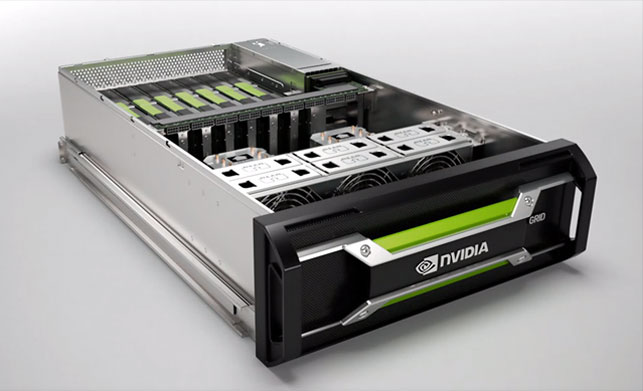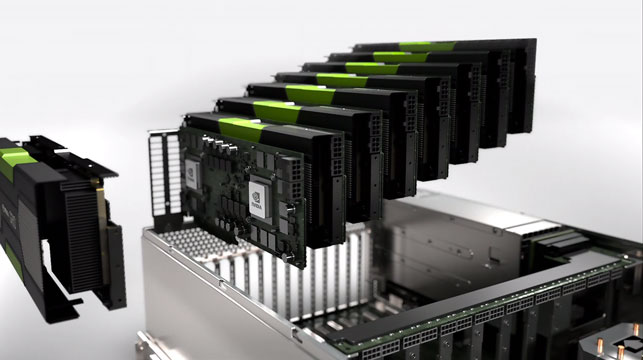Forget desktop workstations, the big news at GTC was the launch of the Nvidia GRID VCA (Visual Computing Appliance) a system that looks to turn any device into a powerful virtual 3D workstation.

This isn’t just for full time CAD users though: Nvidia also sees this as a big opportunity to put high-end 3D performance into the hands of anyone that needs it.
Each GRID VCA can currently only serve up to 16 concurrent users, but the pool can be unlimited. Managers, shop floor workers, marketing folks and clients could all navigate their way around complex 3D CAD data using a standard office laptop.
With GRID VCA, the CAD software runs locally and only the graphics output is streamed to client devices. According to Nvidia, it gives the same rich graphics experience one would get from a high-performance workstation under a desk.
The appliance itself is a fully integrated 4U rack system, which boasts the biggest GPU density in the market. But it’s not just about hardware; there’s also a big focus on deployment.
By providing everything in a single box, Nvidia is targeting small to medium sized firms who don’t have the dedicated in-house IT skills to set up and manage a multi-layered Virtual Desktop Infrastructure (VDI) service.
Nvidia provides the hardware and the virtualisation software (including the client and the hypervisor that creates the virtual machines). A software reseller (VAR) then takes over, managing the installation of the CAD software and the licensing.
According to Nvidia, the GRID VCA should plug into existing network infrastructure. All that’s needed is a standard gigabit network, some NAS storage (most likely a PDM data vault) and some basic knowledge of workgroups.
From the perspective of the user, setup on any device is very straightforward, says Nvidia. Simply install some client software on a PC or laptop and away you go.
The Nvidia client software is currently available for Windows, OSX and Linux so you can run SolidWorks on a Mac without having to reboot with boot camp — though still through a Windows interface. An iOS and Android version will be coming soon adding support for tablets.
Nvidia has initially optimised the system for two 3D products: SolidWorks and Autodesk 3ds Max. Other CAD applications will follow later, but that’s not to say the GRID VCA won’t run all types of Windows-based CAD tools.
Users are able to install software, just as they would on any Windows machine, it just won’t be an optimised, certified platform, as it is for SolidWorks and 3ds Max.
Nvidia has initially concentrated on delivering Quality of Service over LAN but, bandwidth and latency permitting, virtual 3D workstations can also be accessed remotely, from home, overseas, or by off-site contractors.
Enabling flexible working is one benefit, the other is not having to move gigabytes of CAD data around between sites. This not only saves time, but helps protect intellectual property and reduces sync issues between servers.
The hardware
Nvidia currently offers two GRID VCA models.
The ‘base’ system features eight high-end Kepler GPUs, two Intel Xeon processors (16 cores in total), and 192GB of system memory. The hardware costs $24,900 with an annual
software maintenance of $2,400.
The ‘Max’ system doubles up in every department: sixteen Kepler GPUs, four Intel Xeon processors (32 cores) and 384GB of system memory. This beast costs $39,900 with a maintenance fee of $4,800.
With a single ‘Max’ system currently supporting up to 16 concurrent users, a typical virtual machine breaks down to 2 CPU cores, 24GB RAM, and a dedicated high-end Nvidia Kepler GPU, a pretty good configuration for CAD. Later this year when Nvidia adds support for GPU virtualisation this could rise to 32, each having 1 CPU core, 12GB RAM and a half a Kepler GPU.
Sharing resources
Of course, the whole point of virtualisation is flexibility and users have full control over how resources are allocated to each virtual desktop.
For example, an entry-level CAD user might be content with just one CPU core, 8GB RAM and a share of a GPU, while a power user, perhaps one that uses CAD alongside a GPU-accelerated simulation or rendering tool, might demand more CPU cores, more RAM and multiple GPUs.
It’s also possible to combine all the resources to create a massive GPU-based render farm, which is perfect for running complex jobs overnight.

The Nvidia GRID VCA features eight Nvidia GRID K2 cards, each of which features two high performance Kepler GPUs
Unfortunately resources cannot be moved dynamically between virtual desktops, so if all resources are being utilised and one user needs more power, desktop sessions must first be closed and new ones spawned. However, it’s likely firms would implement some sort of ‘best practice’ to manage the resources most effectively.
For example, a CAD user might model on a standard virtual desktop, then spawn a more powerful one whenever they need to render or simulate. There is no limit to the number of desktops spawned for each user, which could be very useful for multi application workflows.
Conclusion
The Nvidia GRID VCA is an exciting proposition for small companies.
It offers huge flexibility for deployment of workstation hardware, can reduce the cost of IT support and, as no CAD data ever leaves the data centre, everything is in sync and secure.
As one would expect from Nvidia, the GRID VCA is heavily loaded with GPUs. While this is great for GPU intensive workflows, those that are more CPU heavy could find it a little unbalanced.
SolidWorks 2013, for example, is very reliant on the CPU when it come to rendering and simulation. However, with DS seemingly a big fan of GPU compute, with both Catia Live Rendering and DS Simulia Abaqus thriving on Nvidia GPUs, it’s quite possible that the next generation of SolidWorks (V6) won’t be.
SolidWorks could well evolve into the perfect bedfellow for such a GPU rich device.
Moving forward, Nvidia has said there will be a whole family of GRID VCAs. It will be interesting to see if new models offer a different ratio of CPU cores to GPUs.
For more on Nvidia GRID VCA and its practical applications read our Nvidia (Graphics Technology Conference (GTC) event report
Remote graphics
The concept of remote graphics is nothing new.
Rack workstations, blade workstations, call them what you will, have been around for some years now, and all the major workstation manufacturers have them in their portfolios.
The idea is the ‘workstation’ sits in a data centre, rather than under a desk. This makes it easier to share resources (users can access their desktop from anywhere, without being tied to a single high-powered workstation), IT administration is much easier (all of the kit is in a rack, instead of under desks) and Intellectual Property theft is not an issue (no CAD data ever leaves the data centre – only pixel data).
Some rack workstations create a one-to-one connection (one machine per CAD user). Others support multiple CAD users by virtualising the CPU, but give each CAD user a dedicated GPU. This is called multi-GPU passthrough.
Hardware based GPU virtualisation is the next step, where both CPU and GPU resources are shared amongst CAD users.
Nvidia’s GRID VCA does not yet support GPU virtualisation, but it will do later this year. Multiple users will be able to share the resources of a high-end GPU, meaning, in theory, a 16 user appliance could become a 32 or 64 user appliance.
The reality is a single GRID VCA system, with its current ratio of CPU and GPU, probably won’t have enough CPU resources to properly support this number of 3D CAD users. However, it will mean GPU resources can be used more smartly: GPUs can be shared for CAD graphics leaving dedicated resources for GPU compute (simulation or rendering).
GPU virtualisation in the GRID VCA will be available later this year, delivered through a software update.






